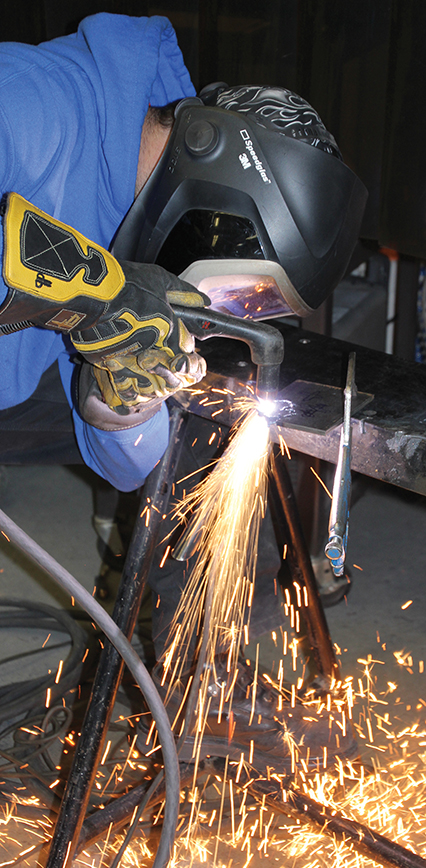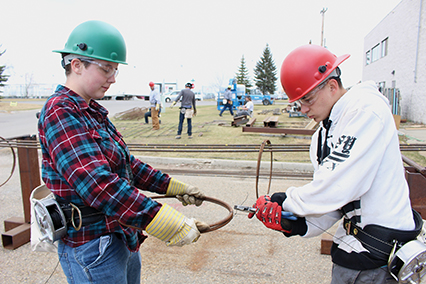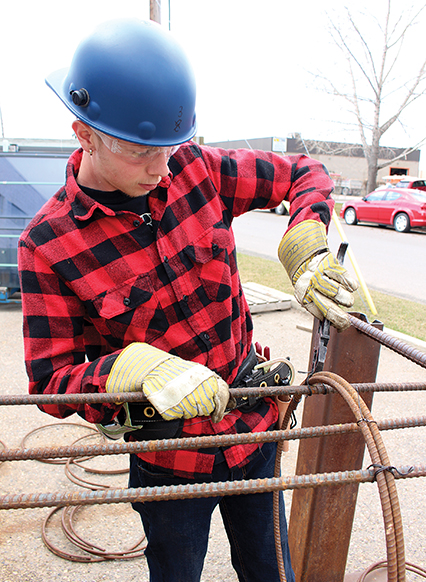Page Content
Calgary Board of Education forges ahead with hands-on exploratory programs
On a windy afternoon outside the Ironworkers Local 725 in southeast Calgary, 11 students clad in work gloves and brightly coloured hard hats are all focused on various pieces of rusty rebar. Some students kneel on the grass, fastening steel bars together with wire to build a structure that could receive a concrete pour, while others work together to build columns, carefully tying wire clockwise around rebar spirals.

A junior high student from Gift Lake participates in the Mind Over Metal welding camp in Edmonton last August. The program was hosted by the Canadian Welding Association in partnership with St. Joseph High School.
These tasks are not commonly associated with high school, but these students appear comfortable, curious and engaged with the work, part of a 16-week exploratory ironworking program taking place four afternoons a week at the union’s building.
“I’m loving it,” says Teigen Heffernan, 15.
Heffernan decided to apply for the ironworking program after enjoying a metal fabrication course he took last semester. He’s not sure yet which trade he will pursue, but the Grade 10 student at Crescent Heights High School already knows he wants a career in the skilled trades.
This program, a partnership between the Calgary Board of Education (CBE) and the Ironworkers Local 725, is one of many exploratory programs, offered across the province, in which local building trade unions and school boards team up to introduce students to the trades. Along the way, students can gain industry-recognized credentials, high school credits for work experience and opportunities for future employment.
 In addition to this affiliation with the ironworkers, the CBE also has partnerships for exploratory off-campus programs with other unions, as well as non-unions, says Don Middleton, a learning specialist in off-campus and dual credit with the board.
In addition to this affiliation with the ironworkers, the CBE also has partnerships for exploratory off-campus programs with other unions, as well as non-unions, says Don Middleton, a learning specialist in off-campus and dual credit with the board.
The Plumbers and Pipefitters Local 496 offers a program at its training school for students interested in the pipe trades, including steamfitting, pipefitting, plumbing, gasfitting, sprinkler installation and welding. Meanwhile, the Local 110 Heat and Frost Insulators offers an insulating program out of different high schools, as no training facility exists in Calgary.
Unions provide instruction and materials free of charge, and also work to help students find employment opportunities.
Middleton has witnessed the difference such programs can make for students.
“Their attendance at school improves, their engagement in their learning goes up, their overall grades have improved, their motivation to complete high school has increased,” he says.
Getting connected
The CBE’s first partnership with a trade union began with the plumbers and pipefitters in September 2013. A former business manager with Local 496 had tried to establish a connection with the CBE for many years, but it took the right timing and people in place to finally make it happen, Middleton says. Also key was the recognition that “success isn’t always defined academically.”
The program with the ironworkers started in 2014. Ironworkers are tradespeople who fabricate, construct and join scaffolding, structural steel buildings, bridges, ornamental ironwork and pre-cast structures. The trade requires a four-year apprenticeship.
The partnership program has 12 spots that are open to high school students in any CBE school. Students adjust their timetables so they can take part, and they are required to find their own transportation to and from the program’s location.
“The trades can be a better fit for lots of kids, but lots of them don’t realize it until later,” says Oakley Cooper, apprenticeship co-ordinator/trainer at the Ironworkers Local 725. “They might not have exposure to the trades. We want to get them interested now.”
For the union, getting high school students interested in the trades early on is one way to combat labour shortages, Cooper says. But even if students don’t find a future career fit, Cooper thinks the experience is worthwhile. He’s seen students grow and develop over the weeks he spends with them, gaining skills they can apply elsewhere.
“I tell students whether or not you become an ironworker, you’re going to get a good flavour for the trades. Even if it doesn’t work out, you’re still going to learn a lot,” Cooper says.
Middleton, with the CBE, estimates that 70 per cent of students completing such exploratory programs find employment in their trade. Some students aren’t ready to enter the workforce, others may decide the trade isn’t for them, and still others may find their various commitments don’t leave time for working.
Such skills-focused programs often feed a misconception that preparing students for the workforce leads to them forgoing high school completion in favour of a paycheque, Middleton says, but he counters that unions, employers and schools all share the same belief: “If they drop out of school, there’s no job for them,” he says.
CBE’s three successful partnerships are prompting the district to pursue even more. An exploratory program with the Boilermakers Lodge 146 will start this summer, and other unions, including electrical workers and sheet metal workers, have also been approached to form potential partnerships.
“We’re open to this type of arrangement, as we feel it’s very beneficial to students,” Middleton says.
Solid foundation
Alberta Teachers’ Association president Mark Ramsankar also sees such exploratory trades programs as positive.
“If we can expose students to as many opportunities as we can while they’re in the K to 12 system, that can be beneficial,” he says.
The foundation of these trades programs is important, Ramsankar adds, noting it’s worth asking why programs are put together and what’s in it for the students. But from what he’s seen, the merits of such programs outweigh potential pitfalls.
“It exposes children to opportunities that are out there that the regular curriculum might not be able to. What it does is it gives them a window to an area of the world they might not be privy to.”

High school students Trinity Sylvester (left) and Austin Racette build a column as part of an exploratory ironworking program offered by the Ironworkers Local 725 in partnership with the Calgary Board of Education.
Back outside the Ironworkers Local 725, Trinity Sylvester and Austin Racette are working together to build a column. There’s a strong sense of camaraderie among the students, who were strangers when the program began. Racette carefully ties wire around a piece of rebar that Sylvester holds steady.
“I like seeing the efforts of my work,” Sylvester, 16, says of ironworking. “I couldn’t do a pencil-pushing job. But this job is exciting and it’s good money too. The program opens lots of doors.”
Racette, 18, says he’s also enjoying the program.
“I want to finish and get a job,” he says.
Instructor Kris Chambers, assistant apprenticeship co-ordinator with the union, said students are taught what’s expected of them on a job site. Attitude and attendance matter, as does a willingness to help out.
“Kids get to see what it’s like to be in the trades. Some find out it’s not for them, and for some it’s been fantastic,” Chambers says.

Student Darian Adam works outside the Ironworkers Local 725 facility in southeast Calgary as part of an exploratory ironworking program offered by the local in partnership with the Calgary Board of Education.
For Darian Adam, a 17-year-old student who attends school at the Calgary Youth Attendance Centre, the program has shown him a future.
“This gives me new opportunities,” he says. “I didn’t do so well in other schools, but I finally have the opportunity to pursue a career.” ❚
